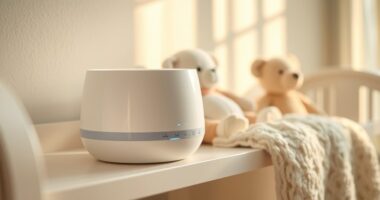When choosing between a walker and a jumper, jumpers tend to win out for safety and developmental benefits. While walkers promote mobility, they also pose serious risks, especially near stairs. Jumpers enhance leg strength and coordination without hindering natural movement. You’ll find that supervised play in a jumper creates a more secure environment. Ultimately, balancing safety and development is key, and there’s more to consider as you make your choice.
Key Takeaways
- Jumpers enhance leg muscle development and coordination without hindering natural walking progression, making them more beneficial for physical growth.
- Walkers provide mobility but can delay independent walking skills and pose safety risks, especially around stairs and hot surfaces.
- Jumpers are stationary, creating a safer environment for play compared to the mobile nature of walkers, which require constant supervision.
- Design preferences can influence parental choices, but jumpers are generally favored for their focus on strength and safety features.
- Informed decision-making prioritizes developmental needs and safety, making jumpers often the better choice over walkers for child growth.

When it comes to choosing between a baby walker and a jumper, which one truly stands out for your little one’s development? Both tools have their merits, but they cater to different aspects of your baby’s growth. Walkers offer mobility, allowing your child to explore their environment, while jumpers focus on strengthening leg muscles through bouncing motions. The choice you make should hinge on your baby’s specific needs and safety considerations.
Safety is a significant factor when comparing these devices. Walkers can pose serious risks, particularly near stairs or hot surfaces, where falls can occur. In contrast, jumpers are generally stationary, reducing the likelihood of accidents. Even though both require supervision, jumpers create a more secure environment for play. Engaging in safe play practices is crucial to minimize risks while using these devices.
Moreover, while walkers can provide too much support, potentially delaying your child’s independent walking skills, jumpers promote strength and coordination without hindering natural progression. Baby jumpers enhance leg muscle development through interactive exercise, making them beneficial for your child’s physical growth.
When discussing developmental impact, it’s essential to recognize that each device plays a unique role. Walkers can encourage mobility, but they often limit independent practice of walking. On the other hand, jumpers offer a fun way to exercise, enhancing leg strength and coordination. Both devices contribute to overall physical development, but jumpers tend to be more beneficial, especially for leg strength.
Each device serves a unique purpose; walkers promote mobility, while jumpers enhance leg strength and coordination for better development.
Design and functionality are also worth considering. Walkers feature wheels for movement and often come with play trays or toys to keep your baby entertained. While they require smooth surfaces for optimal use, jumpers are stationary and focus solely on the bouncing motion.
If you’re looking for an alternative, exersaucers and Jumperoos prioritize play and leg strength, providing different options for your baby’s development.
Parental preferences play a role in this decision too. Some parents lean toward walkers for the mobility they offer, while others prefer jumpers for their safety features and focus on strength. Your baby’s age and weight may also affect your choice. Generally, jumpers are recommended for their safety and developmental benefits.
Ultimately, the decision between a baby walker and a jumper should prioritize safety and your child’s developmental needs. Jumpers are often the safer bet, promoting leg strength and reducing risks. While walkers can provide mobility, they come with significant safety concerns.
Remember to supervise your child while using either device and make an informed choice that supports their growth.
Frequently Asked Questions
What Are the Main Differences Between Walkers and Jumpers?
When considering the main differences between walkers and jumpers, you’ll notice that walkers allow babies to move around on wheels, while jumpers provide a stationary bouncing experience.
Safety is a key factor; walkers can lead to accidents, whereas jumpers are generally safer.
Additionally, walkers support an upright position, while jumpers encourage natural movement.
Finally, walkers focus on mobility, while jumpers prioritize play and sensory exploration, making them a better choice for developmental benefits.
Can a Walker or Jumper Be More Fun for Kids?
When considering whether a walker or jumper is more fun for kids, it really depends on what they enjoy.
Walkers offer independence and the chance to explore their surroundings, which can be exciting.
On the other hand, jumpers promote natural movement and sensory stimulation, keeping kids engaged through bouncing and play.
Both options provide unique experiences, so it’s worth trying both to see what your child enjoys most!
Are Walkers or Jumpers Safer for Infants?
When considering safety for infants, jumpers are generally a better option than walkers.
Walkers can quickly lead your baby into hazardous areas, increasing the risk of falls and injuries.
In contrast, jumpers provide a secure, stationary environment, allowing your child to play safely while still promoting muscle development.
They encourage natural movement and exploration without the dangers associated with mobility, making them a safer choice for your little one’s playtime.
What Age Is Suitable for Using Walkers or Jumpers?
When it comes to your little one’s mobility, you want to strike while the iron’s hot.
For baby walkers, the sweet spot is typically between 6 to 16 months, while jumpers are best suited for infants around 3 to 12 months.
Remember, safety’s key—both devices should be used cautiously to avoid any developmental delays.
Always keep an eye on your baby’s progress and consult with a healthcare professional before introducing new equipment.
Do Walkers or Jumpers Promote Better Physical Development?
When considering which option promotes better physical development, you’ll find that jumpers generally encourage natural movement and muscle strengthening without hindering walking skills.
They help improve coordination and provide a safe environment for exercise.
In contrast, walkers can offer excessive support, possibly delaying independent walking and contributing to posture issues.
Conclusion
In the end, whether you choose to walk or jump, it’s all about the journey. Like a nimble gazelle leaping gracefully across a savanna or a steadfast tortoise steadily making its way to victory, both paths hold their own merits. If you crave speed and thrill, jumping might be your ticket. But if you value endurance and steadiness, walking’s your best bet. Whichever you pick, embrace the adventure ahead and let your spirit soar!









